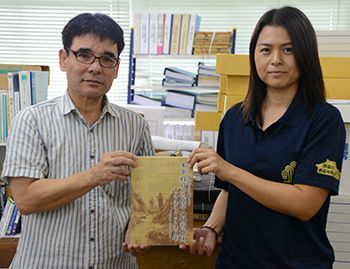Revealed: why the U.S. military built civilian internment camps during the Battle of Okinawa

Nago City Municipal Board of Education Cultural Division City History Section member Akira Kawamitsu (left) and Section Chief Akiko Matsubara (right) who gave a summary of the city’s anthology, taken on April 25 at the former Sakiyama Library in Nago City.
May 8, 2019 Ryukyu Shimpo
Nago City, Okinawa Prefecture published an anthology on the city’s history titled “The U.S. Military Operations and Civilian Internment Districts 1945-1946 – Centered in Yambaru, Nago.” It contains translations of records by U.S. military officers and photographs from the time. It also sheds light on the U.S. military administration’s aim and circumstances that led to the establishment of civilian internment camps. On April 25, members of the Nago City Municipal Board of Education Cultural Division City History Section held a press conference at the former Sakiyama Library to give a summary of the anthology.
The anthology is based on the “Papers of James T. Watkins,” a collection of U.S. military reports and journals, which were compiled by U.S. military officer James Thomas Watkins. Using the location names from the documents as clues, resources related to the northern area of the main island of Okinawa were sought out to be translated into Japanese, then included in the anthology.
The anthology makes it clear that the U.S. military was executing military operations based on elaborate statistics. In a report that is included in the anthology states that 60-thousand refugees were in the south-central area due to the Battle of Okinawa. City History Section member Akira Kawamitsu explained, “Unlike the Japanese military, the U.S. military had a grasp of everything and matter-of-factly carried out the Battle of Okinawa.”
Meanwhile, a different report states that civilians were relocated to a different area so the U.S. military could use the internment camps for a different purpose during the Battle of Okinawa. Kawamitsu stressed that, “The U.S. military was looking at the Okinawan citizens from the perspective of ‘What should we do with the residents that are in the way?’ We can see that the troops weren’t there to protect the residents.”
The content of the anthology is meant to complement the “History of Nago City 3 – Battle of Okinawa in Yambaru, Nago ” that was published in 2016. With the publication of the anthology, publication of “History of Nago City 3 – Battle of Okinawa Series -” has come to an end, but Kawamitsu said, “In preparation for next year, we hope to work on a collection of testimonies (by those who experienced the Battle of Okinawa).” The anthology can still be purchased at the Nago Museum and bookstores within Nago City. It can also be mailed if the purchase is made from outside the city. They are 1,700-yen each including tax. For more information, contact the Nago City Municipal Board of Education Cultural Division City History Section at 0980 (53) 5402.
(English translation by T&CT and Chelsea Ashimine)
Previous Article:Photo Gallery: Once in 50-year deluge hammers Yonaguni Island
Next Article:Drone restrictions reform could inhibit press freedom and citizens’ access to information
[Similar Articles]
- Request to survey Battle of Okinawa remains in Camp Schwab sent to US embassy
- For the first time in 43 years, a collection of new research on the Battle of Okinawa published
- Ourasaki Memorial Service at Henoko; prayers for war dead
- Complaints from local residents after six CH 46 helicopters fly over Ginowan City
- Anthology of Okinawan contemporary literature published
 Webcam(Kokusai Street)
Webcam(Kokusai Street)


